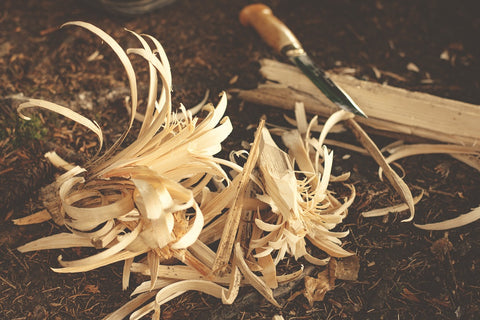
With fall upon us in full swing, many parts of the country will enter a period of rain before the frost begins to set in. It's not yet cold enough in the fall to dissuade many campers, casual and frequent alike. Fall hiking is some of my favorite hiking weather, as we aren't dealing with extreme cold or heat. The sun may set earlier as Fall sets in, but this gives us more time together around the campfire as well! Speaking of your campfire - if you're thinking of a Fall camping trip, you may want to know how to start a fire in the rain or post-rain. As I mentioned, rain is going to cover many parts of the country. While rain can certainly put a damper on your trip, it in no way means you should reschedule or write it off as a bad experience. Of course severe rains should certainly be avoided, but a sprinkle or some intermittent rain showers is nothing to be afraid of. With proper planning and the right tools, starting a fire in the wet is no problem at all. However, if you don't have any of the modern tools it does become more difficult - but not impossible!

If you have the proper tools you can start a fire in almost any condition. But for the sake of this article, let's pretend we only have the faithful Ferro Rod. Firestarter ropes and pre-packaged tinder are usable in any conditions, so long as they've been properly stored, so the hardest part of starting your fire is already done for you. If you're harvesting everything needed for your fire by hand, you will absolutely need some tools. The first recommendation is a hatchet or axe - as this will make splitting wood to get to the dry interiors much easier. A sturdy survival knife can also fit the bill, but a hatchet is truly the right tool for the job. A hand saw or similar tool can be helpful as well, but you'll expend significantly more energy using a saw than you would a hatchet - at least when it comes to splitting.
First and foremost you'll need a dry area to set your fire. Especially under heavy rains, keeping your tinder dry so you can grow the flames is the most important factor to consider. If you can create an overhang with a poncho, tarp, or rainfly, this would be ideal as it allows you to keep it close to your shelter. Otherwise you can look for natural overhangs that would provide some relief from the rainfall. Next you'll need to create a raised bed, laying some logs is the easiest way to do this. Otherwise, you can stack rocks to create a raised fire bed structure. I would recommend using logs, however, and as an additional step you can strip the bark from the exterior to make this as dry as possible.

Wet wood will not catch so you need to find dry wood one way or the other. Dead trees will almost always be dry on the interior, regardless of how much rain has soaked the area. Traditional tinder sources, such as barks and leaves will be soaked through, meaning they will be completely unusable as tinder. Finding a dead tree or branch is going to be your best bet for dry material - using your axe or knife to split it in two or more pieces, accessing the dry interior. From here, use a knife to 'feather' the wood, creating a series of thin shavings. You can also remove some shavings entirely, creating a nice pile of dry tinder, while a larger branch with feathered shavings still attached can serve as kindling. The idea here is to make it as easy as possible for fire to catch, as a juvenile fire will be quickly stifled in the rain and high winds.
Before you light your tinder, be sure you have enough fuel handy to support a fire for the length of time you might need. A good rule of thumb is to collect as much firewood as you'll think you need - and then double it. Your primary source should be split and dry, but it isn't unreasonable to have a reserve source of firewood close to the fire to dry it out. Having a few bundles of split wood ready is vital to keeping the fire going, especially in the early stages. With a handful of thinly sliced wood shavings, you have a bed of tinder. Using the ferro rod, scrape some material into the pile over the shavings. Then you'll want to attempt to get a spark to catch on the tinder pile, allowing it to blossom into a flame before you continue feeding it fuel.
There are some instances in which starting a fire in heavy rains would be even more difficult, if not close to impossible. With the proper knowledge and tools however, it is certainly not improbable. While it may be more difficult and cost you more energy to get a fire going, it makes it even more worth doing so. A fire to keep the chill away and dry yourself and gear off goes a long way. However, if you want to avoid the extra hassle, firestarting kits like ours provide everything you need to start a fire in any condition.

